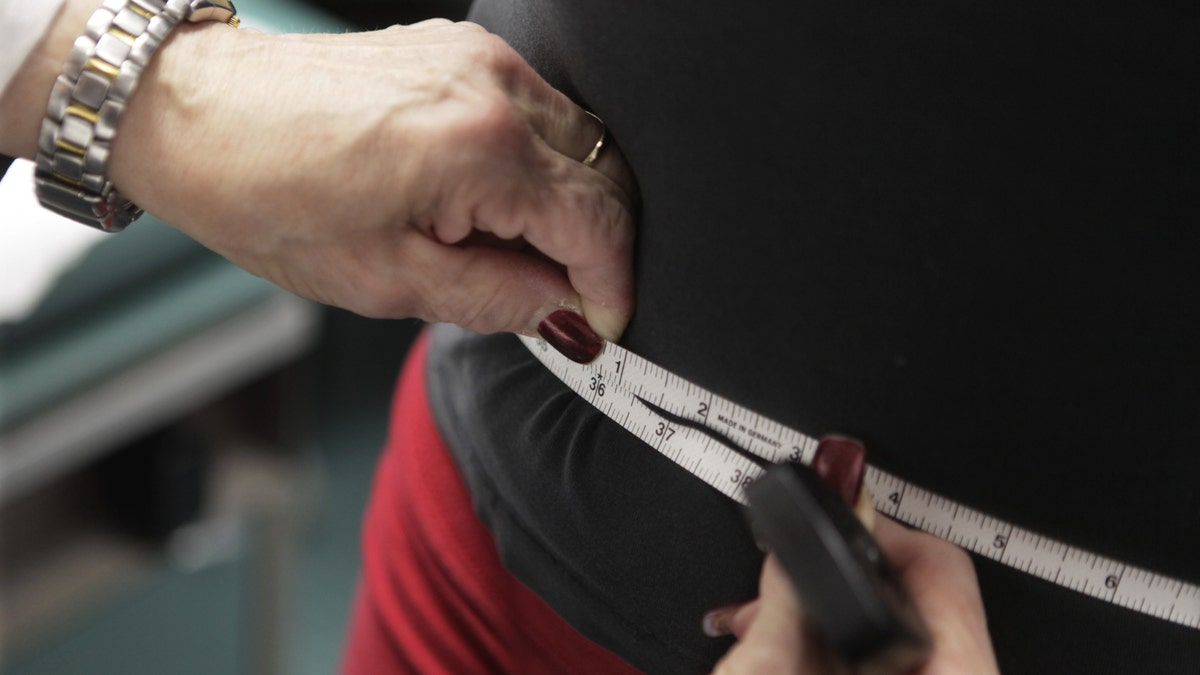
FILE - In this Jan. 20, 2010, file photo, a waist is measured during an obesity prevention study at Rush University Medical Center in Chicago. The bathroom scale may show a good number but how much of that weight is fat, not muscle? New studies are adding to the evidence that the scale doesn't always tell the whole story when it comes to weight-related health risks. (AP Photo/M. Spencer Green, File)
NEW YORK (AP) -- When New York City public schools began giving students report cards on their weight a decade ago, officials hoped the information would help fight an obesity epidemic in the nation's largest school system. But a new study finds being labeled fat doesn't spur weight loss, at least among students near the threshold for being flagged.
The study, released Monday in the Proceedings of the National Academy of Sciences, adds to the debate over the effects of student body-mass index reports now issued in many schools nationwide.
"It's not enough just to get the information out there," said one of the authors, Syracuse University education and economics professor Amy Ellen Schwartz. "You have to get it to people in a way that's actionable."
After weighing and measuring its 1.1 million students, the school system gave each reports including a BMI number, weight percentile and, until last year, a designation: "underweight," ''healthy weight," ''overweight" or "obese." Those outside "healthy weight" were advised to consult a health professional.
After the study ended, the school district tweaked the language, substituting "needs improvement" for "overweight" or "obese."
The reports aim "to spark conversations about eating habits and levels of physical activity needed for good health," spokeswoman Toya Holness said in a statement.
Using four years of measurements for all New York public school students, Schwartz, Columbia University economist Douglas Almond and Columbia graduate student Ajin Lee compared boys and girls just over the "overweight" or "obese" threshold for their age.
The researchers found no indication that those over the lines lost weight. In fact, the average overweight girl gained a bit more than did her cohort just below the threshold.
Although U.S. childhood obesity rates have leveled off in recent years, even declining among preschoolers, more than one-third of children and adolescents nationwide were overweight or obese as of 2012, according to the federal Centers for Disease Control and Prevention.
The National Institute of Medicine has recommended in-school BMI screenings, which debuted in Arkansas in 2003. At least 19 states now have instituted them, though only some require reporting the information to parents.
Proponents see the readouts as inexpensive, relatively unobtrusive tools to apply to a major public health problem.
Critics feel the approach stigmatizes children and fuels unhealthy anxieties about weight, based on a measurement that can mistake a muscular kid for a flabby one. Massachusetts abandoned its BMI-reporting requirement in 2013, though parents still can request the information.
Research has found mixed results. Child obesity rates leveled off in Arkansas in the first four years of school screenings, but they were implemented alongside other anti-obesity measures. A study published last year in the Journal of Adolescent Health found the BMI reports alone had no impact on Arkansas juniors and seniors, who had already learned their measurements in earlier grades.
Studies in California, Massachusetts and Mexico also have found school BMI reports don't have significant effects on students' waistlines.
The New York City study provides "the strongest evidence so far" because of its size and ability to track individual students anonymously, said Kevin Gee, a University of California at Davis education professor who conducted the recent Arkansas study.
Overweight students might have dismissed the information as nothing they didn't know, suggested Schwartz, who plans to study how to make the reports more effective.
Schools could try coupling BMI measurements with more comprehensive information about weight management, said Dr. Fatima Cody Stanford, an obesity doctor and Harvard University instructor who studied Massachusetts' former BMI reporting program.
